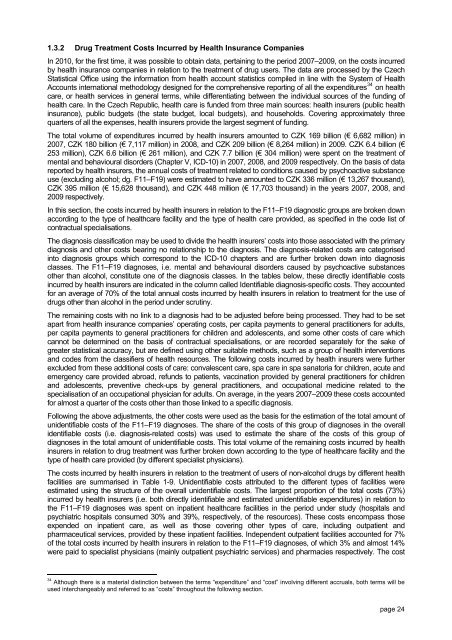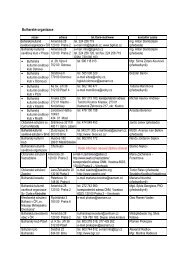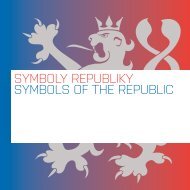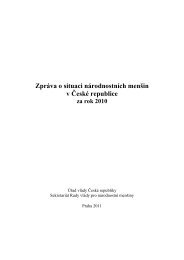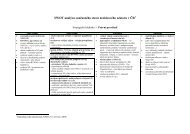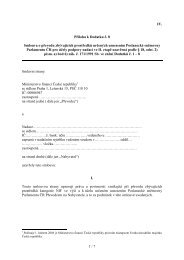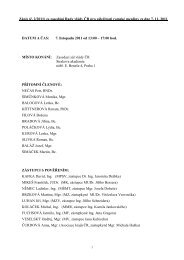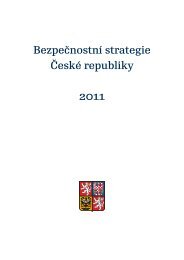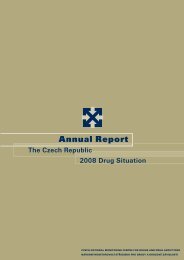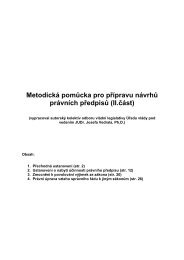The Czech Republic Annual Report 2010 Drug ... - Drogy-info.cz
The Czech Republic Annual Report 2010 Drug ... - Drogy-info.cz
The Czech Republic Annual Report 2010 Drug ... - Drogy-info.cz
Create successful ePaper yourself
Turn your PDF publications into a flip-book with our unique Google optimized e-Paper software.
1.3.2 <strong>Drug</strong> Treatment Costs Incurred by Health Insurance Companies<br />
In <strong>2010</strong>, for the first time, it was possible to obtain data, pertaining to the period 2007–2009, on the costs incurred<br />
by health insurance companies in relation to the treatment of drug users. <strong>The</strong> data are processed by the <strong>Czech</strong><br />
Statistical Office using the <strong>info</strong>rmation from health account statistics compiled in line with the System of Health<br />
Accounts international methodology designed for the comprehensive reporting of all the expenditures 34 on health<br />
care, or health services in general terms, while differentiating between the individual sources of the funding of<br />
health care. In the <strong>Czech</strong> <strong>Republic</strong>, health care is funded from three main sources: health insurers (public health<br />
insurance), public budgets (the state budget, local budgets), and households. Covering approximately three<br />
quarters of all the expenses, health insurers provide the largest segment of funding.<br />
<strong>The</strong> total volume of expenditures incurred by health insurers amounted to CZK 169 billion (€ 6,682 million) in<br />
2007, CZK 180 billion (€ 7,117 million) in 2008, and CZK 209 billion (€ 8,264 million) in 2009. CZK 6.4 billion (€<br />
253 million), CZK 6.6 billion (€ 261 million), and CZK 7.7 billion (€ 304 million) were spent on the treatment of<br />
mental and behavioural disorders (Chapter V, ICD-10) in 2007, 2008, and 2009 respectively. On the basis of data<br />
reported by health insurers, the annual costs of treatment related to conditions caused by psychoactive substance<br />
use (excluding alcohol; dg. F11–F19) were estimated to have amounted to CZK 336 million (€ 13,267 thousand),<br />
CZK 395 million (€ 15,628 thousand), and CZK 448 million (€ 17,703 thousand) in the years 2007, 2008, and<br />
2009 respectively.<br />
In this section, the costs incurred by health insurers in relation to the F11–F19 diagnostic groups are broken down<br />
according to the type of healthcare facility and the type of health care provided, as specified in the code list of<br />
contractual specialisations.<br />
<strong>The</strong> diagnosis classification may be used to divide the health insurers’ costs into those associated with the primary<br />
diagnosis and other costs bearing no relationship to the diagnosis. <strong>The</strong> diagnosis-related costs are categorised<br />
into diagnosis groups which correspond to the ICD-10 chapters and are further broken down into diagnosis<br />
classes. <strong>The</strong> F11–F19 diagnoses, i.e. mental and behavioural disorders caused by psychoactive substances<br />
other than alcohol, constitute one of the diagnosis classes. In the tables below, these directly identifiable costs<br />
incurred by health insurers are indicated in the column called Identifiable diagnosis-specific costs. <strong>The</strong>y accounted<br />
for an average of 70% of the total annual costs incurred by health insurers in relation to treatment for the use of<br />
drugs other than alcohol in the period under scrutiny.<br />
<strong>The</strong> remaining costs with no link to a diagnosis had to be adjusted before being processed. <strong>The</strong>y had to be set<br />
apart from health insurance companies’ operating costs, per capita payments to general practitioners for adults,<br />
per capita payments to general practitioners for children and adolescents, and some other costs of care which<br />
cannot be determined on the basis of contractual specialisations, or are recorded separately for the sake of<br />
greater statistical accuracy, but are defined using other suitable methods, such as a group of health interventions<br />
and codes from the classifiers of health resources. <strong>The</strong> following costs incurred by health insurers were further<br />
excluded from these additional costs of care: convalescent care, spa care in spa sanatoria for children, acute and<br />
emergency care provided abroad, refunds to patients, vaccination provided by general practitioners for children<br />
and adolescents, preventive check-ups by general practitioners, and occupational medicine related to the<br />
specialisation of an occupational physician for adults. On average, in the years 2007–2009 these costs accounted<br />
for almost a quarter of the costs other than those linked to a specific diagnosis.<br />
Following the above adjustments, the other costs were used as the basis for the estimation of the total amount of<br />
unidentifiable costs of the F11–F19 diagnoses. <strong>The</strong> share of the costs of this group of diagnoses in the overall<br />
identifiable costs (i.e. diagnosis-related costs) was used to estimate the share of the costs of this group of<br />
diagnoses in the total amount of unidentifiable costs. This total volume of the remaining costs incurred by health<br />
insurers in relation to drug treatment was further broken down according to the type of healthcare facility and the<br />
type of health care provided (by different specialist physicians).<br />
<strong>The</strong> costs incurred by health insurers in relation to the treatment of users of non-alcohol drugs by different health<br />
facilities are summarised in Table 1-9. Unidentifiable costs attributed to the different types of facilities were<br />
estimated using the structure of the overall unidentifiable costs. <strong>The</strong> largest proportion of the total costs (73%)<br />
incurred by health insurers (i.e. both directly identifiable and estimated unidentifiable expenditures) in relation to<br />
the F11–F19 diagnoses was spent on inpatient healthcare facilities in the period under study (hospitals and<br />
psychiatric hospitals consumed 30% and 39%, respectively, of the resources). <strong>The</strong>se costs encompass those<br />
expended on inpatient care, as well as those covering other types of care, including outpatient and<br />
pharmaceutical services, provided by these inpatient facilities. Independent outpatient facilities accounted for 7%<br />
of the total costs incurred by health insurers in relation to the F11–F19 diagnoses, of which 3% and almost 14%<br />
were paid to specialist physicians (mainly outpatient psychiatric services) and pharmacies respectively. <strong>The</strong> cost<br />
34<br />
Although there is a material distinction between the terms “expenditure” and “cost” involving different accruals, both terms will be<br />
used interchangeably and referred to as “costs” throughout the following section.<br />
page 24


